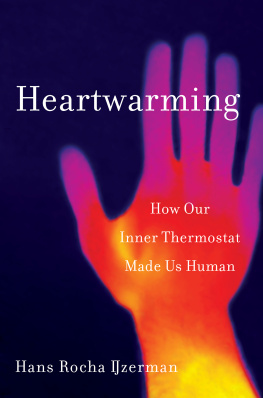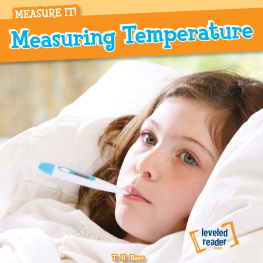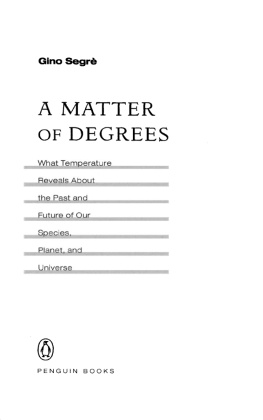Contents
Guide

HEARTWARMING
How Our Inner Thermostat
Made Us Human
Hans Rocha IJzerman

p. 199: Holt-Lunstad Table used by permission of Julianne Holt-Lunstad.
Copyright 2021 by Hans Rocha IJzerman
All rights reserved
First Edition
For information about permission to reproduce selections from this book, write to Permissions, W. W. Norton & Company, Inc., 500 Fifth Avenue, New York, NY 10110
For information about special discounts for bulk purchases, please contact W. W. Norton Special Sales at specialsales@wwnorton.com or 800-233-4830
Jacket design: Yang Kim
Jacket photograph: iStock / Getty Images Plus
Book design by Lovedog Studio
Production manager: Julia Druskin
The Library of Congress has cataloged the printed edition as follows:
Names: IJzerman, Hans Rocha, author.
Title: Heartwarming : how our inner thermostat made us human / Hans Rocha IJzerman.
Description: First edition. | New York, NY : W. W. Norton & Company, [2021] | Includes bibliographical references and index.
Identifiers: LCCN 2020025838 | ISBN 9781324002529 (hardcover) | ISBN 9781324002536 (epub)
Subjects: LCSH: Body temperature. | Body temperatureRegulation. | Body temperatureSocial aspects. | Body temperaturePsychological aspects.
Classification: LCC QP135 .I39 2021 | DDC 612/.01426dc23
LC record available at https://lccn.loc.gov/2020025838
W. W. Norton & Company, Inc., 500 Fifth Avenue, New York, N.Y. 10110
www.wwnorton.com
W. W. Norton & Company Ltd., 15 Carlisle Street, London W1D 3BS
To my source of warmth, my wife, Dani, and to our little kleptotherm, Julie
CONTENTS
Temperature and Relationships
Temperature and Embodied Cognition
How Animals Deal with Temperature
The Workings of Our Inner Thermostat(s)
Temperature and Attachment
How Culture Transforms Social Thermoregulation
Temperature in Marketing
Temperature as Treatment
Temperature, Weather, and Well-Being
HEARTWARMING
Temperature and Relationships
Sheldon Cooper walks into the living room of his apartment and notices his two best friends, Leonard and Howard, and the tense gloom that surrounds them.
Whats going on? he asks.
Oh, Howards gonna sleep here tonight. He had a fight with his mother, Leonard explains.
Did you offer him a hot beverage?
Leonard just stares back at Sheldon in confusion. Howard, slumped on the couch, says nothing, either.
Leonard! Social protocol states: when a friend is upset, you offer them a hot beverage, such as tea.
Tea does sound nice, Howard admits.
Sheldon, one of the lead characters on the television sitcom The Big Bang Theory , may have given rise to cynical internet memes focused on his propensity to cheer up his friends with hot beverages, but he is certainly not alone in thinking that physical warmth and moral support go well together.1 For centuries, songwriters and poets have linked love and caring with pleasantly elevated temperatures, while loneliness and betrayal were deemed chilly. Barbra Streisand sang about being home again and warm all over. The Brazilian band Jota Quest, meanwhile, belted out that love is the warmth that heats the soul, and the Beatles claimed that happiness is a warm gun, ironically twisting Peanuts cartoonist Charles M. Schulzs famous Happiness is a warm puppy.
Even our everyday language teems with such metaphors. A warm person is a caring and responsive person. We may get a warm reception or an icy stare. A Pole may mwi ciepo (speak warmly) about another, while in France people sometimes battre froid a quelquun (literally, beat cold to someone, which in idiomatic English would be give someone the cold shoulder).
Back in 1946, Solomon Asch, one of the fathers of modern social psychology, found in his experiments that adding the word warm or cold to a description of a person significantly changes how others view that individual. You may be viewed as intelligent, skillful, or determined, yet that wont matter as much as whether you are also warm or perhaps cold. One who is warm, Asch discovered, is perceived as generous, sociable, good natured. To be cold is not only to lack such qualities but also to be seen as displaying their opposites: to be stingy, aloof, mean spirited.2 Asch believed that the warm-cold dimension was fundamental to social perception. Yet it took years before science began unraveling the fact that this fundamental quality was not a product of simple linguistics or contrived metaphor. We were actuallyliterallyfeeling the physical warmth or chill of our relationships.
Fast-forward to the twenty-first century. Its 2008, and in the majestic buildings of Yale University a rather simple experiment is being conducted. A volunteer, an undergrad student, enters the lobby of the psychology building. She is met there by a female research assistant who offers to accompany her to the fourth-floor lab, where the student is to volunteer in an experiment. The assistants hands are full: she is carrying a cup of coffee, a clipboard, and two textbooks. The two women head for an elevator.
Inside, the research assistant asks the student to briefly hold her cup as she scribbles something on the clipboard. Soon the doors ping open, and they both step out.
Unbeknownst to the student, the first part of the experiment is already over. Once inside the lab, she will be asked to read a description of a fictional person A, who is intelligent, skillful, industrious, determined, practical, and cautious. The students task will be to rate A on 10 personality traits, 5 of them semantically related to either warm or cold.
What the 41 undergraduate students who have participated in this particular experiment didnt know was that the researchers had already divided them into two groups. In the elevator, half of them were asked to hold a disposable cup of steaming coffee from Willoughbys, their local coffee shop. The other half were handed a cup of iced coffee. This little trick was enough to affect the students perceptions of A. Those who had handled the hot drink thought A was significantly warmer than did those who had held the iced coffee. For psychologists, these findings were groundbreaking. They meant that experiencing physical warmth could actually prompt an increased judgment of psychological or social warmth.3
The experiment opened the floodgates of researchincluding my owninto the links between temperature and sociability.
If briefly holding a warm beverage was enough to make us think of others as sociable and trustworthy, could it also make us feel closer to them? Not physically closer, but psychologically and sociallyin the way we talk about close friends or close family members? I became determined to find out.
A year after the coffee-in-the-elevator study, I published my own variation, together with my academic advisor at Utrecht University. We had devised a tea-in-the-lab study, in which we asked the participants to hold a cup for an experimenter while she busied herself with installing a questionnaire on a laptop computer. Once again, half of the volunteers were handed a warm container, while the rest ended up with a cold one. (In the Netherlands a few years back, iced coffee was not a common drink. Fearing that Dutch people would find the beverage weird, we substituted tea, which was much more familiar to the Dutch in both hot and cold versions.) Whether in an elevator or a lab, giving people a warm or cold drink to hold influenced the subjects perception of others.











